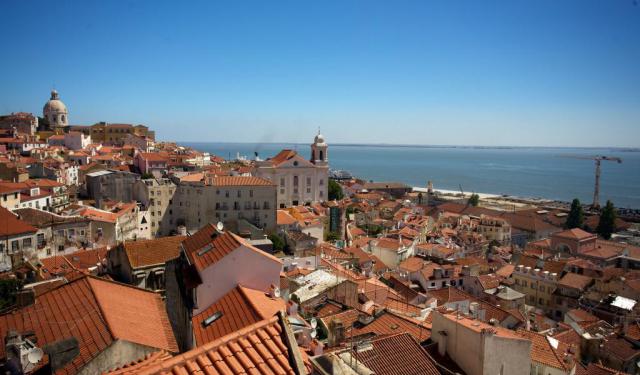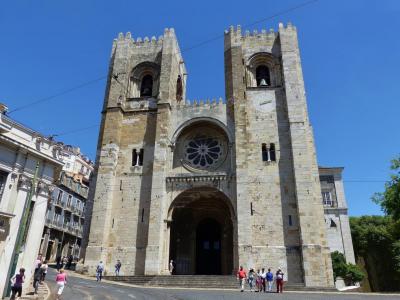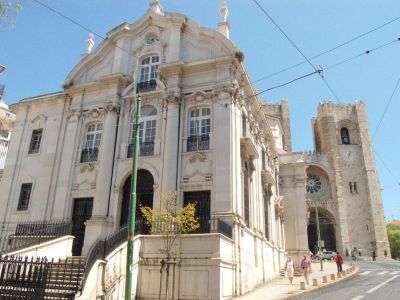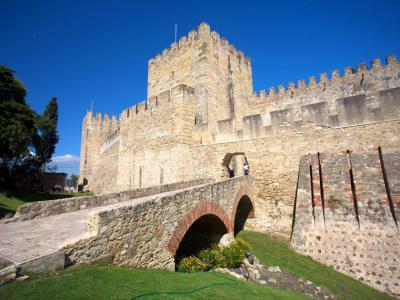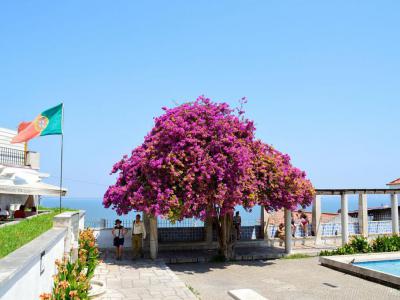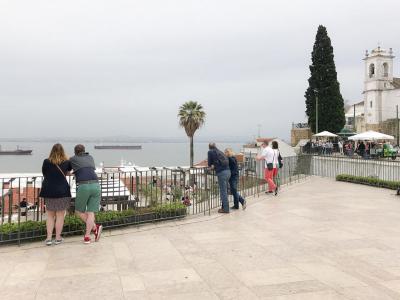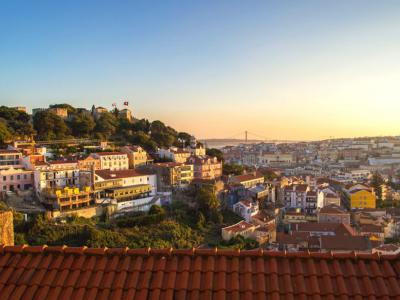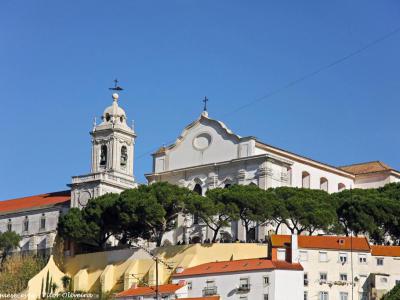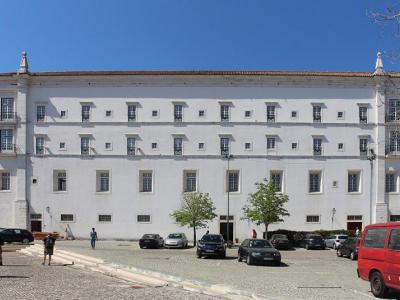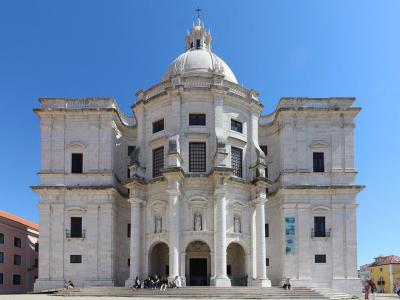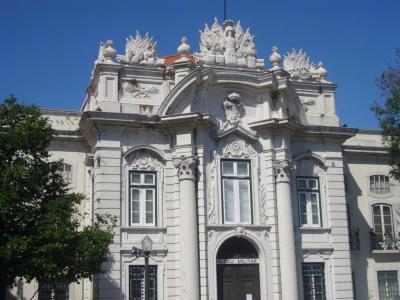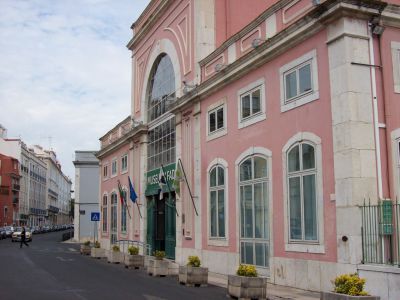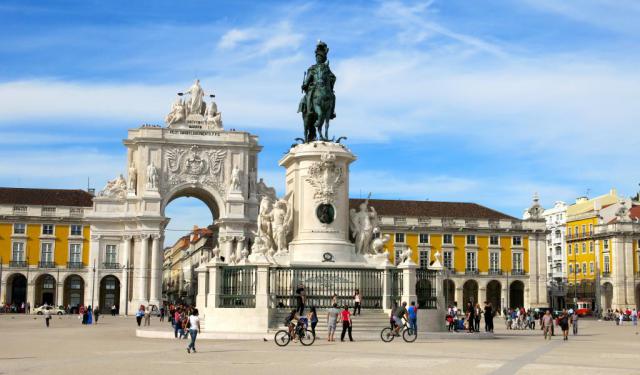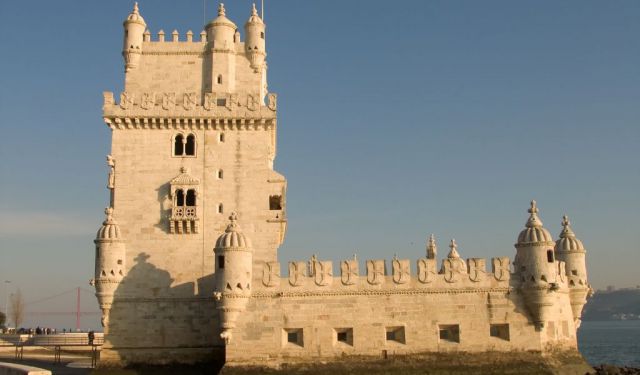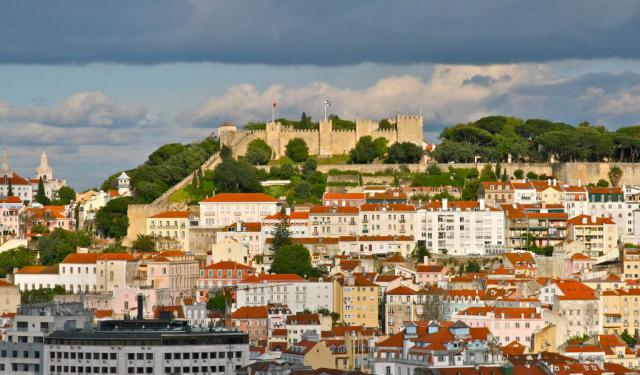Audio Guide: Alfama Walking Tour (Self Guided), Lisbon
Alfama, the oldest district of Lisbon, spreads downhill along the Tagus River. It retains a charmingly labyrinthine layout with narrow alleys and steep streets. Under Islamic rule, this part of the city was increasingly inhabited by fishermen and the poor. The reputation of being a poor area still lives on. The name Alfama derives from the Arabic al-ḥamma, which means "hot fountains" or "baths," akin to "hammam."
The great Lisbon earthquake of 1755, which ravaged much of the capital, spared Alfama. Nowadays, the historic tram no. 28, winding its way up through the district, is a key local landmark in its own right.
At the heart of Alfama stands the Santa Maria Maior Cathedral. A formidable edifice originally constructed in 1147, it has withstood the test of time and serves as a testament to Lisbon's resilience. Nearby, Saint Anthony's Church marks the birthplace of this beloved saint. The neighborhood bursts into festive decor and parades in his honor every June.
Dominating the district's skyline, Saint George's Castle offers panoramic views of the city. This medieval stronghold, dating back to the 11th century, is a cornerstone of Lisbon’s historical narrative. For more breathtaking vistas, Alfama is generously dotted with viewpoints. The Santa Luzia and the Gates of the Sun viewpoints provide sweeping views of the Tagus River and the rooftops of Alfama, while the Grace Viewpoint offers a picturesque spot to watch sunsets.
The spiritual and cultural depth of Alfama is further exemplified by the Grace Church and Convent and the Monastery of Saint Vincent, both monumental sites that have been there for centuries. The National Pantheon, which houses the tombs of significant historical figures, and the nearby Lisbon Military Museum offer deep dives into Portugal's past. Lastly, the essence of the Portuguese soul is captured at the Fado Museum, dedicated to the traditional melancholy music genre that originated in these very alleys.
For anyone looking to experience the essence of the Portuguese capital, Alfama is not merely a neighborhood but a vibrant canvas displaying the cultural and historical richness of Lisbon. Stroll through its streets, let the Fado melodies guide you, and immerse yourself in the historical marvels that await around every corner. Rediscover the past and witness the continuity of culture in Alfama on this self-guided tour.
The great Lisbon earthquake of 1755, which ravaged much of the capital, spared Alfama. Nowadays, the historic tram no. 28, winding its way up through the district, is a key local landmark in its own right.
At the heart of Alfama stands the Santa Maria Maior Cathedral. A formidable edifice originally constructed in 1147, it has withstood the test of time and serves as a testament to Lisbon's resilience. Nearby, Saint Anthony's Church marks the birthplace of this beloved saint. The neighborhood bursts into festive decor and parades in his honor every June.
Dominating the district's skyline, Saint George's Castle offers panoramic views of the city. This medieval stronghold, dating back to the 11th century, is a cornerstone of Lisbon’s historical narrative. For more breathtaking vistas, Alfama is generously dotted with viewpoints. The Santa Luzia and the Gates of the Sun viewpoints provide sweeping views of the Tagus River and the rooftops of Alfama, while the Grace Viewpoint offers a picturesque spot to watch sunsets.
The spiritual and cultural depth of Alfama is further exemplified by the Grace Church and Convent and the Monastery of Saint Vincent, both monumental sites that have been there for centuries. The National Pantheon, which houses the tombs of significant historical figures, and the nearby Lisbon Military Museum offer deep dives into Portugal's past. Lastly, the essence of the Portuguese soul is captured at the Fado Museum, dedicated to the traditional melancholy music genre that originated in these very alleys.
For anyone looking to experience the essence of the Portuguese capital, Alfama is not merely a neighborhood but a vibrant canvas displaying the cultural and historical richness of Lisbon. Stroll through its streets, let the Fado melodies guide you, and immerse yourself in the historical marvels that await around every corner. Rediscover the past and witness the continuity of culture in Alfama on this self-guided tour.
How it works: Download the app "GPSmyCity: Walks in 1K+ Cities" from Apple App Store or Google Play Store to your mobile phone or tablet. The app turns your mobile device into a personal tour guide and its built-in GPS navigation functions guide you from one tour stop to next. The app works offline, so no data plan is needed when traveling abroad.
Alfama Walking Tour Map
Guide Name: Alfama Walking Tour
Guide Location: Portugal » Lisbon (See other walking tours in Lisbon)
Guide Type: Self-guided Walking Tour (Sightseeing)
# of Attractions: 11
Tour Duration: 2 Hour(s)
Travel Distance: 3.0 Km or 1.9 Miles
Author: DanaOffice
Sight(s) Featured in This Guide:
Guide Location: Portugal » Lisbon (See other walking tours in Lisbon)
Guide Type: Self-guided Walking Tour (Sightseeing)
# of Attractions: 11
Tour Duration: 2 Hour(s)
Travel Distance: 3.0 Km or 1.9 Miles
Author: DanaOffice
Sight(s) Featured in This Guide:
- Santa Maria Maior (Cathedral of St. Mary Major)
- Igreja de Santo Antonio de Lisboa (St. Anthony's Church)
- Castelo de Sao Jorge (Saint George's Castle)
- Miradouro de Santa Luzia (Santa Luzia Viewpoint)
- Miradouro das Portas do Sol (Gates of the Sun Viewpoint)
- Miradouro da Graca (Grace Viewpoint)
- Igreja e Convento da Graca (Grace Church and Convent)
- Mosteiro de Sao Vicente de Fora (Monastery of St. Vincent Outside the Walls)
- Panteao Nacional (National Pantheon)
- Museu Militar de Lisboa (Lisbon Military Museum)
- Museu do Fado (Fado Museum)
1) Santa Maria Maior (Cathedral of St. Mary Major)
The Cathedral of Saint Mary Major, often called Lisbon Cathedral or simply the Sé, is a Roman Catholic cathedral and the oldest church in the city. Built in 1147, it has survived many earthquakes and been modified, renovated, and restored numerous times, resulting in a mix of different architectural styles. The seat of the Patriarchate of Lisbon, it has been classified as a National Monument since 1910.
The first cathedral in Lisbon was constructed on the site of the former Moorish mosque shortly after the Second Crusade led by King Afonso Henriquez in the mid-1100s. During this pivotal period, the relics of Saint Vincent of Saragossa, the city's patron saint, were transported from Southern Portugal and enshrined here, remaining undisturbed ever since. Recent excavations in the cathedral's cloister have uncovered Roman, Visigothic, and medieval remains, emphasizing the site's historical layers.
Lisbon Cathedral, a fortress-like structure with a Latin cross layout, maintains its Romanesque roots from the 12th century. The cathedral's robust façade features two towers and crenellations, a design typical of Portuguese cathedrals from the Reconquista era, indicating its historical military significance. The interior preserves the original west façade with a rose window, Romanesque portals, and barrel vaulting.
Transitioning to Gothic architecture in the late 13th century under King Dinis, the cathedral saw the addition of a Gothic cloister, although much of it was later damaged by the 1755 earthquake. Noteworthy Gothic elements include the ambulatory with its radiating chapels and ribbed vaulting, enhancing the structure with ample light and housing significant tombs from the mid-14th century.
The cathedral also hosted the Saint Vincent Panels until the 17th century. The 18th century brought neoclassical and Rococo refurbishments post-earthquake, with significant contributions from the renowned local sculptor Machado de Castro.
Efforts in the 20th century aimed to restore the cathedral's medieval character by removing neoclassical elements. This renovation imbued the structure with a predominantly medieval aesthetic, characterized by robust stone walls and fortress-like towers.
Notable among its chapels is the Chapel of Saint Ildefonso, housing a carved sculpture of one of the first Portuguese Ambassadors, Lopo Pacheco, depicted with a loyal dog at his side. Additionally, the Cathedral includes a chapel dedicated to Saint Anthony of Padua, a celebrated figure born in Lisbon.
Tip:
Admission to the Cathedral is free. For a modest fee, between 10 am and 5 pm, you can also ascend partway up the tower to the Treasury. Please note that it is closed on Sundays.
The first cathedral in Lisbon was constructed on the site of the former Moorish mosque shortly after the Second Crusade led by King Afonso Henriquez in the mid-1100s. During this pivotal period, the relics of Saint Vincent of Saragossa, the city's patron saint, were transported from Southern Portugal and enshrined here, remaining undisturbed ever since. Recent excavations in the cathedral's cloister have uncovered Roman, Visigothic, and medieval remains, emphasizing the site's historical layers.
Lisbon Cathedral, a fortress-like structure with a Latin cross layout, maintains its Romanesque roots from the 12th century. The cathedral's robust façade features two towers and crenellations, a design typical of Portuguese cathedrals from the Reconquista era, indicating its historical military significance. The interior preserves the original west façade with a rose window, Romanesque portals, and barrel vaulting.
Transitioning to Gothic architecture in the late 13th century under King Dinis, the cathedral saw the addition of a Gothic cloister, although much of it was later damaged by the 1755 earthquake. Noteworthy Gothic elements include the ambulatory with its radiating chapels and ribbed vaulting, enhancing the structure with ample light and housing significant tombs from the mid-14th century.
The cathedral also hosted the Saint Vincent Panels until the 17th century. The 18th century brought neoclassical and Rococo refurbishments post-earthquake, with significant contributions from the renowned local sculptor Machado de Castro.
Efforts in the 20th century aimed to restore the cathedral's medieval character by removing neoclassical elements. This renovation imbued the structure with a predominantly medieval aesthetic, characterized by robust stone walls and fortress-like towers.
Notable among its chapels is the Chapel of Saint Ildefonso, housing a carved sculpture of one of the first Portuguese Ambassadors, Lopo Pacheco, depicted with a loyal dog at his side. Additionally, the Cathedral includes a chapel dedicated to Saint Anthony of Padua, a celebrated figure born in Lisbon.
Tip:
Admission to the Cathedral is free. For a modest fee, between 10 am and 5 pm, you can also ascend partway up the tower to the Treasury. Please note that it is closed on Sundays.
2) Igreja de Santo Antonio de Lisboa (St. Anthony's Church)
The Church of Saint Anthony of Lisbon, a Roman Catholic church, is a tribute to Saint Anthony of Lisbon, also known as Saint Anthony of Padua. It is famously located at the site where the saint was born in 1195 and has been designated a National Monument. The church's origins trace back to a 15th-century chapel built over Saint Anthony's family home, near the Lisbon Cathedral. This structure underwent several reconstructions, the most notable being during King Manuel I's reign, in the early 16th century, and later, in the 18th century, under King John V.
The 1755 Lisbon earthquake devastated the church, leaving only the main chapel intact. It was subsequently rebuilt in a Baroque-Rococo style post-1767. Unique funding efforts for the rebuild included collections from the city’s children who asked for "a small coin for Saint Anthony." The tradition of venerating Saint Anthony continues robustly with crafted thrones and altars in his honor during Lisbon’s popular June festivities, dedicated to him.
Saint Anthony is deeply revered in Lisbon, not only as the patron saint but also as a matchmaker. Traditionally, couples visit the church on their wedding day to seek blessings for their marriage. Each year on June 13, Saint Anthony's feast day, a procession significant to the city’s cultural and religious calendar, starts from this church, passing the Lisbon Cathedral, and meandering through the Alfama neighborhood.
Pope John Paul II visited the church on May 12, 1982. He inaugurated a statue of Saint Anthony and prayed in the crypt-the only part of the church dating back to 1195-where a tile panel commemorates his visit. The crypt marks the spot where the saint was born and is a poignant site for pilgrims and visitors.
Tip:
Adjacent to the church, you'll find a small museum housing paintings, sculptures, and manuscripts associated with Saint Anthony. Museum admission is fairly cheap, with free entry on Sundays until 2 pm and when using the Lisboa Card. If you have a penchant for acquiring religious souvenirs during your travels, you'll discover a selection of medals, statues, and other items available at the church as well.
The 1755 Lisbon earthquake devastated the church, leaving only the main chapel intact. It was subsequently rebuilt in a Baroque-Rococo style post-1767. Unique funding efforts for the rebuild included collections from the city’s children who asked for "a small coin for Saint Anthony." The tradition of venerating Saint Anthony continues robustly with crafted thrones and altars in his honor during Lisbon’s popular June festivities, dedicated to him.
Saint Anthony is deeply revered in Lisbon, not only as the patron saint but also as a matchmaker. Traditionally, couples visit the church on their wedding day to seek blessings for their marriage. Each year on June 13, Saint Anthony's feast day, a procession significant to the city’s cultural and religious calendar, starts from this church, passing the Lisbon Cathedral, and meandering through the Alfama neighborhood.
Pope John Paul II visited the church on May 12, 1982. He inaugurated a statue of Saint Anthony and prayed in the crypt-the only part of the church dating back to 1195-where a tile panel commemorates his visit. The crypt marks the spot where the saint was born and is a poignant site for pilgrims and visitors.
Tip:
Adjacent to the church, you'll find a small museum housing paintings, sculptures, and manuscripts associated with Saint Anthony. Museum admission is fairly cheap, with free entry on Sundays until 2 pm and when using the Lisboa Card. If you have a penchant for acquiring religious souvenirs during your travels, you'll discover a selection of medals, statues, and other items available at the church as well.
3) Castelo de Sao Jorge (Saint George's Castle) (must see)
Saint George’s Castle is a historic fortress in Lisbon’s Santa Maria Maior district. Its hilltop location has been occupied since the 8th century BC, with fortifications dating back to the 2nd century BC. Over time, the site reflected influences from the Celts, Phoenicians, Greeks, Carthaginians, Romans, Suebi, Visigoths, and Moors. The Berbers added the so-called “Moorish Encirclement” walls in the 10th century, and the Moors held the castle until the Christian Reconquista.
The castle played a pivotal role during the 1147 Siege of Lisbon when it was captured in a major Second Crusade victory. This fortified stronghold became a royal residence in 1255 and was named after Saint George in the 14th century by King John I to symbolize ties with England. In the later period, it served as a military barracks and home to Portugal’s National Archive. Although damaged in the 1755 earthquake, the 20th-century restorations regained its prominence as a national monument and cultural site.
Within this castle complex, you'll find medieval architecture with ten towers, a dry moat, and steep hillsides for natural defense. Highlights include the terraced Arms Square with cannons and a statue of Afonso Henriques, the first king of Portugal, and the Tower of Ulysses, which houses a camera obscura offering shows (every 20 minutes) in various languages, including English, Portuguese, and Spanish. The citadel's primary entrance features a 19th-century gate adorned with Portugal's coat of arms, Queen Maria II's name, and the date 1846.
Inside, visitors can enjoy a range of amenities, including restaurants, cafes, a wine bar, an ice cream stand, and public restrooms. Peacocks roam freely throughout the grounds, particularly in one of the primary dining areas. While dining within the castle walls may be slightly pricier than in the surrounding areas, it is not excessively so. Alternatively, you have the option of bringing your own food and beverages. Admission is reasonably priced and children enter for free.
Saint George’s Castle also includes the ruins of a royal palace, such as the Casa Ogival, which is now home to the Olissipónia multimedia exhibit detailing Lisbon’s history. Gardens and historical artifacts enhance the experience, making the castle a symbol of Lisbon’s rich past and an essential cultural landmark.
Tip:
Although the journey to the castle involves a steep uphill climb, it provides a delightful stroll through the narrow streets of historic Lisbon, with numerous opportunities to stop and savor local cuisine. Alternatively, you can take cable car #28 to admire the neighborhood's charming and diverse architecture, providing excellent photo opportunities.
The castle played a pivotal role during the 1147 Siege of Lisbon when it was captured in a major Second Crusade victory. This fortified stronghold became a royal residence in 1255 and was named after Saint George in the 14th century by King John I to symbolize ties with England. In the later period, it served as a military barracks and home to Portugal’s National Archive. Although damaged in the 1755 earthquake, the 20th-century restorations regained its prominence as a national monument and cultural site.
Within this castle complex, you'll find medieval architecture with ten towers, a dry moat, and steep hillsides for natural defense. Highlights include the terraced Arms Square with cannons and a statue of Afonso Henriques, the first king of Portugal, and the Tower of Ulysses, which houses a camera obscura offering shows (every 20 minutes) in various languages, including English, Portuguese, and Spanish. The citadel's primary entrance features a 19th-century gate adorned with Portugal's coat of arms, Queen Maria II's name, and the date 1846.
Inside, visitors can enjoy a range of amenities, including restaurants, cafes, a wine bar, an ice cream stand, and public restrooms. Peacocks roam freely throughout the grounds, particularly in one of the primary dining areas. While dining within the castle walls may be slightly pricier than in the surrounding areas, it is not excessively so. Alternatively, you have the option of bringing your own food and beverages. Admission is reasonably priced and children enter for free.
Saint George’s Castle also includes the ruins of a royal palace, such as the Casa Ogival, which is now home to the Olissipónia multimedia exhibit detailing Lisbon’s history. Gardens and historical artifacts enhance the experience, making the castle a symbol of Lisbon’s rich past and an essential cultural landmark.
Tip:
Although the journey to the castle involves a steep uphill climb, it provides a delightful stroll through the narrow streets of historic Lisbon, with numerous opportunities to stop and savor local cuisine. Alternatively, you can take cable car #28 to admire the neighborhood's charming and diverse architecture, providing excellent photo opportunities.
4) Miradouro de Santa Luzia (Santa Luzia Viewpoint)
The Viewpoint de Santa Luzia in Lisbon presents a stunning overlook of the Alfama district and the Tagus River. From this vantage point, visitors can see significant landmarks such as the National Pantheon of Santa Engracia, the Church of Santo Estevao, and the spires of Sao Miguel Church. This viewpoint is noted for offering similarly picturesque, albeit slightly less commanding, views to those at the nearby Gates of the Sun viewpoint.
Encompassing the traditional tiled roofs and historical churches of Alfama stretching out towards the Tagus estuary, the view from Santa Luzia is enhanced with its inviting ambiance. This site features a beautifully landscaped garden on multiple levels, with azalea trees, ample seating under pergola-like structures, and walls adorned with traditional blue "azulejo" tiles. One particularly notable azulejo panel illustrates the "Reconquista"-the historical liberation of the Iberian Peninsula from Moorish rule in 1147-which is displayed on the exterior wall of the adjacent Santa Luzia church.
Dating back to the 12th century, this church was largely rebuilt after the devastating 1755 earthquake. Despite its unassuming exterior, it has a cross-shaped layout and a richly decorated Baroque interior. Its façade is highlighted with azulejo tiles that depict important moments of the Portuguese past. Another azulejo mural depicts Commerce Square before it was destroyed in the 1755 earthquake, offering a historical snapshot to visitors.
Conveniently, the Santa Luzia and Gates of the Sun viewpoints are just a short walk from each other, allowing visitors to enjoy both spots in a single trip. The area also includes a small café and restrooms. The latter are found nearby, after a short ascent up the hill, around the corner from the church, and down a set of steps.
Tip:
Visiting the Santa Luzia Viewpoint is recommended either early in the morning or late in the afternoon to catch the exquisite sunrises or sunsets. Summers tend to be crowded and hot, so preparing for high temperatures and sun exposure is crucial. Visiting outside the peak tourist season can offer a cooler and more tranquil experience.
Be sure to keep an eye out for the small market nearby, offering various cork products and textiles, often at more reasonable prices than elsewhere in the city, making it an excellent spot for picking up souvenirs.
Encompassing the traditional tiled roofs and historical churches of Alfama stretching out towards the Tagus estuary, the view from Santa Luzia is enhanced with its inviting ambiance. This site features a beautifully landscaped garden on multiple levels, with azalea trees, ample seating under pergola-like structures, and walls adorned with traditional blue "azulejo" tiles. One particularly notable azulejo panel illustrates the "Reconquista"-the historical liberation of the Iberian Peninsula from Moorish rule in 1147-which is displayed on the exterior wall of the adjacent Santa Luzia church.
Dating back to the 12th century, this church was largely rebuilt after the devastating 1755 earthquake. Despite its unassuming exterior, it has a cross-shaped layout and a richly decorated Baroque interior. Its façade is highlighted with azulejo tiles that depict important moments of the Portuguese past. Another azulejo mural depicts Commerce Square before it was destroyed in the 1755 earthquake, offering a historical snapshot to visitors.
Conveniently, the Santa Luzia and Gates of the Sun viewpoints are just a short walk from each other, allowing visitors to enjoy both spots in a single trip. The area also includes a small café and restrooms. The latter are found nearby, after a short ascent up the hill, around the corner from the church, and down a set of steps.
Tip:
Visiting the Santa Luzia Viewpoint is recommended either early in the morning or late in the afternoon to catch the exquisite sunrises or sunsets. Summers tend to be crowded and hot, so preparing for high temperatures and sun exposure is crucial. Visiting outside the peak tourist season can offer a cooler and more tranquil experience.
Be sure to keep an eye out for the small market nearby, offering various cork products and textiles, often at more reasonable prices than elsewhere in the city, making it an excellent spot for picking up souvenirs.
5) Miradouro das Portas do Sol (Gates of the Sun Viewpoint)
The Gates of the Sun viewpoint, akin to a home’s balcony, sits above the ancient neighborhood Alfama. Just steps away from the Santa Luzia viewpoint, it offers stunning views across Alfama and the Tagus River. The layout of Alfama unfolds below in a picturesque maze of streets, stairways, and alleys, all visible from this panoramic balcony.
Visitors to the Gates of the Sun viewpoint can indulge in authentic Portuguese coffee at the local kiosk, watch the iconic #28 electric tram pass by, and view the statue of Saint Vincent, the patron saint of Lisbon, symbolically holding a boat flanked by two ravens, representing the city. Additionally, from this point, one can see the Church of Saint Vincent and the expanse of the Alfama neighborhood stretching to the Tagus River.
Installed in 1949, a statue of Saint Vincent enhances the cultural significance of the viewpoint. The location is also prime for photographers, who find the backdrop of the Decorative Arts Museum and the panoramic view from Saint Vincent de Fora Monastery to the waterfront irresistibly photogenic.
Tip:
For a unique and enjoyable experience, seek out a flight of stairs and follow the WC (restroom) sign. Descend the stairs and pass under an arch to discover a mural depicting Lisbon's history in a comic-book style.
The view surprises at dusk, when the sun goes down and the colors of Lisbon’s architecture turn another shade.
Visitors to the Gates of the Sun viewpoint can indulge in authentic Portuguese coffee at the local kiosk, watch the iconic #28 electric tram pass by, and view the statue of Saint Vincent, the patron saint of Lisbon, symbolically holding a boat flanked by two ravens, representing the city. Additionally, from this point, one can see the Church of Saint Vincent and the expanse of the Alfama neighborhood stretching to the Tagus River.
Installed in 1949, a statue of Saint Vincent enhances the cultural significance of the viewpoint. The location is also prime for photographers, who find the backdrop of the Decorative Arts Museum and the panoramic view from Saint Vincent de Fora Monastery to the waterfront irresistibly photogenic.
Tip:
For a unique and enjoyable experience, seek out a flight of stairs and follow the WC (restroom) sign. Descend the stairs and pass under an arch to discover a mural depicting Lisbon's history in a comic-book style.
The view surprises at dusk, when the sun goes down and the colors of Lisbon’s architecture turn another shade.
6) Miradouro da Graca (Grace Viewpoint) (must see)
The Grace Viewpoint in Lisbon is a celebrated vantage point situated atop the southern slope of Santo André Hill. It offers panoramic views of the city's historic center stretching, on clear days, to the Tagus River estuary.
This viewpoint is not only a daytime delight but also a magical evening spot as the setting sun casts a golden hue over Lisbon and the city lights begin to twinkle. The atmosphere here is perpetually vibrant, enhanced by performances from local musicians and singers, while the adjacent Esplanada da Graça café remains abuzz with activity.
Though many tourists stop at this viewpoint, they often overlook nearby attractions such as the expansive Grace Convent, noted for its exquisite tile paintings and baroque architecture. Other local sights include the 19th-century Villa Sousa and the serene Cerca Park Garden, with a quaint fountain and a bronze sculpture, positioned below the viewpoint.
From here, visitors can enjoy a 160-degree view encompassing central and western Lisbon. To the southwest, prominent visible landmarks include Saint George's Castle, the Carmo Church ruins, and the April 25 bridge. The viewpoint also overlooks the Mouraria neighborhood and Martim Moniz plaza and offers glimpses of distant sites like the Monsanto Forest and the Amoreiras Towers.
Despite its common designation as the Grace viewpoint, its official title "Sophia de Mello Breyner Andresen" honors the esteemed 20th-century Portuguese poet revered for her fairy tales and the official Portuguese translations of Shakespeare. Her affinity for this location, where she drew much inspiration, led to its renaming following her death in 2004 and is now marked by a bust near the Grace Convent entrance.
This viewpoint frequently marks the conclusion of a journey for those ascending the hill from Alfama and Saint George's Castle. The series of steps leading to it are paved with traditional cobblestone designs.
This viewpoint is not only a daytime delight but also a magical evening spot as the setting sun casts a golden hue over Lisbon and the city lights begin to twinkle. The atmosphere here is perpetually vibrant, enhanced by performances from local musicians and singers, while the adjacent Esplanada da Graça café remains abuzz with activity.
Though many tourists stop at this viewpoint, they often overlook nearby attractions such as the expansive Grace Convent, noted for its exquisite tile paintings and baroque architecture. Other local sights include the 19th-century Villa Sousa and the serene Cerca Park Garden, with a quaint fountain and a bronze sculpture, positioned below the viewpoint.
From here, visitors can enjoy a 160-degree view encompassing central and western Lisbon. To the southwest, prominent visible landmarks include Saint George's Castle, the Carmo Church ruins, and the April 25 bridge. The viewpoint also overlooks the Mouraria neighborhood and Martim Moniz plaza and offers glimpses of distant sites like the Monsanto Forest and the Amoreiras Towers.
Despite its common designation as the Grace viewpoint, its official title "Sophia de Mello Breyner Andresen" honors the esteemed 20th-century Portuguese poet revered for her fairy tales and the official Portuguese translations of Shakespeare. Her affinity for this location, where she drew much inspiration, led to its renaming following her death in 2004 and is now marked by a bust near the Grace Convent entrance.
This viewpoint frequently marks the conclusion of a journey for those ascending the hill from Alfama and Saint George's Castle. The series of steps leading to it are paved with traditional cobblestone designs.
7) Igreja e Convento da Graca (Grace Church and Convent)
The Church and Convent of Grace in Lisbon is an ecclesiastical complex and historic monument. Originally, it served as the spiritual center for the Order of Saint Augustine, known locally as the Order of the Gracians.
Established during the formation of the Portuguese nation, the Convent of Grace was founded in the era of Afonso Henriques' siege of Lisbon in 1147. It was strategically positioned on the Mount of Saint Gens, an area then called Almofala. Construction of the convent began in 1271 under the patronage of King Afonso III, intending to house 50 hermit friars of Saint Augustine.
By 1291, the convent emerged as the head of the Portuguese Province of the Order of Saint Augustine, maintaining this role until the religious orders were dissolved in 1834. Significant religious events have taken place here, including the miraculous appearance of the Image of Our Lady of Grace in 1362.
The convent was fortified by the Fernandina wall in 1375 and contains chapels established by notable Portuguese figures such as Rui Gomes de Alvarenga (a nobleman of the Council of Kings John I, Duarte, and Afonso V) and Afonso de Albuquerque (a military commander and the second governor of Portuguese India). The latter is also buried here.
The architectural significance of the site includes a blend of styles due to various reconstructions, particularly after the 1755 earthquake which necessitated major restoration efforts, imbuing the structure with late Baroque and rocaille elements. Its interior is lavishly adorned with opulent gilt carvings, grisaille paintings, azulejo tiles from various centuries, and other decorations, notably in the sacristy. Upon entering, you'll be greeted by intriguing elements: an ornate painted ceiling, a somewhat imposing statue of Saint Tomás of Villanova, two finely adorned marble chairs in the sacristy, and a collection of gilded Rococo-style sculptures within the chapels.
The focal point of the church, an image of Christ bearing the cross, has been a fixture in the annual Easter procession since 1587. However, the real treasure awaits in the adjoining convent-a pristine white room adorned with tiled walls hailing from the 16th, 17th, and 18th centuries, depicting grand historical scenes. It's worth noting that there is no admission fee for any of these remarkable sights.
During the 19th century, the convent served as military barracks. Both, the Church and the Convent of Grace were designated a National Monument in 1910. However, this historic site was made accessible to the public only in 2017.
Established during the formation of the Portuguese nation, the Convent of Grace was founded in the era of Afonso Henriques' siege of Lisbon in 1147. It was strategically positioned on the Mount of Saint Gens, an area then called Almofala. Construction of the convent began in 1271 under the patronage of King Afonso III, intending to house 50 hermit friars of Saint Augustine.
By 1291, the convent emerged as the head of the Portuguese Province of the Order of Saint Augustine, maintaining this role until the religious orders were dissolved in 1834. Significant religious events have taken place here, including the miraculous appearance of the Image of Our Lady of Grace in 1362.
The convent was fortified by the Fernandina wall in 1375 and contains chapels established by notable Portuguese figures such as Rui Gomes de Alvarenga (a nobleman of the Council of Kings John I, Duarte, and Afonso V) and Afonso de Albuquerque (a military commander and the second governor of Portuguese India). The latter is also buried here.
The architectural significance of the site includes a blend of styles due to various reconstructions, particularly after the 1755 earthquake which necessitated major restoration efforts, imbuing the structure with late Baroque and rocaille elements. Its interior is lavishly adorned with opulent gilt carvings, grisaille paintings, azulejo tiles from various centuries, and other decorations, notably in the sacristy. Upon entering, you'll be greeted by intriguing elements: an ornate painted ceiling, a somewhat imposing statue of Saint Tomás of Villanova, two finely adorned marble chairs in the sacristy, and a collection of gilded Rococo-style sculptures within the chapels.
The focal point of the church, an image of Christ bearing the cross, has been a fixture in the annual Easter procession since 1587. However, the real treasure awaits in the adjoining convent-a pristine white room adorned with tiled walls hailing from the 16th, 17th, and 18th centuries, depicting grand historical scenes. It's worth noting that there is no admission fee for any of these remarkable sights.
During the 19th century, the convent served as military barracks. Both, the Church and the Convent of Grace were designated a National Monument in 1910. However, this historic site was made accessible to the public only in 2017.
8) Mosteiro de Sao Vicente de Fora (Monastery of St. Vincent Outside the Walls)
The Church and Monastery of Saint Vincent “Outside the Walls” in Lisbon is a prominent 17th-century Mannerist structure. Originally founded by Afonso Henriques, the first Portuguese King, around 1147 for the Augustinian Order, the monastery was built outside the city walls, hence its name. It was dedicated to Saint Vincent of Saragossa, the patron saint of Lisbon, whose relics were transferred here in the 12th century.
The existing structures are largely due to the reconstruction efforts ordered by King Philip I of Portugal in 1580. The church itself was constructed between 1582 and 1629. The monastery's buildings were completed in the 18th century, following the designs influenced by the Jesuit church of The Gesù in Rome.
A key feature of the church is its austere façade with Mannerist influences, attributed to Portuguese architect Baltazar Álvares. It includes niches with statues of saints, flanked by two towers, and features a Latin cross floor plan with a one-aisled nave and lateral chapels, covered by barrel vaulting and a large dome over the crossing.
The monastery is renowned for its extensive collection of azulejo ceramic tiles, showcasing over 150 panels depicting various scenes from life in the countryside to noble amusements, created during two major periods in the 18th century under King Joao V. The main Baroque-style altarpiece, crafted by one of Portugal's finest sculptors, Joaquim Machado de Castro, and several fine altarpieces in the lateral chapels further enhance its artistic heritage.
Post the 1834 dissolution of monasteries in Portugal, the monastery was repurposed, serving as a palace for the archbishops of Lisbon and later housing the royal pantheon for the Braganza monarchs, initiated by King Ferdinand II. This sequence of resting places spans from João IV, who restored the monarchy in 1640, to Manuel II, the last Portuguese monarch, who passed away in exile in England in 1932. Among these notable figures is also Catherine of Braganza, the widow of England's Charles II, credited with introducing the concept of "teatime" to the British.
The baroque portal and the cloisters, decorated with 18th-century tiles and themes from La Fontaine's fables, along with a sacristy richly adorned with polychrome marble and artwork, contribute to its grandeur.
However, the highlight of your visit is undoubtedly the ascent to the towers' terraces, providing some of the most stunning panoramic views over the Alfama district and the Tagus River.
Tip:
Upon purchasing your ticket, you will receive a leaflet containing a map and a concise history of the monastery. It's highly recommended to follow the map to ensure you don't miss any of the monastery's captivating features.
The existing structures are largely due to the reconstruction efforts ordered by King Philip I of Portugal in 1580. The church itself was constructed between 1582 and 1629. The monastery's buildings were completed in the 18th century, following the designs influenced by the Jesuit church of The Gesù in Rome.
A key feature of the church is its austere façade with Mannerist influences, attributed to Portuguese architect Baltazar Álvares. It includes niches with statues of saints, flanked by two towers, and features a Latin cross floor plan with a one-aisled nave and lateral chapels, covered by barrel vaulting and a large dome over the crossing.
The monastery is renowned for its extensive collection of azulejo ceramic tiles, showcasing over 150 panels depicting various scenes from life in the countryside to noble amusements, created during two major periods in the 18th century under King Joao V. The main Baroque-style altarpiece, crafted by one of Portugal's finest sculptors, Joaquim Machado de Castro, and several fine altarpieces in the lateral chapels further enhance its artistic heritage.
Post the 1834 dissolution of monasteries in Portugal, the monastery was repurposed, serving as a palace for the archbishops of Lisbon and later housing the royal pantheon for the Braganza monarchs, initiated by King Ferdinand II. This sequence of resting places spans from João IV, who restored the monarchy in 1640, to Manuel II, the last Portuguese monarch, who passed away in exile in England in 1932. Among these notable figures is also Catherine of Braganza, the widow of England's Charles II, credited with introducing the concept of "teatime" to the British.
The baroque portal and the cloisters, decorated with 18th-century tiles and themes from La Fontaine's fables, along with a sacristy richly adorned with polychrome marble and artwork, contribute to its grandeur.
However, the highlight of your visit is undoubtedly the ascent to the towers' terraces, providing some of the most stunning panoramic views over the Alfama district and the Tagus River.
Tip:
Upon purchasing your ticket, you will receive a leaflet containing a map and a concise history of the monastery. It's highly recommended to follow the map to ensure you don't miss any of the monastery's captivating features.
9) Panteao Nacional (National Pantheon)
The soaring white dome of Saint Engratia sets it apart as the tallest church in Lisbon. Originally a 17th-century church in the city's Alfama neighborhood, it now serves as the National Pantheon of Portugal, housing the tombs of notable Portuguese figures.
The church traces its origin back to around 1568, initiated by Infanta Maria of Portugal, daughter of King Manuel I. She established the first church dedicated to Saint Engratia, a martyr from Braga (a town in the northwest of Portugal). However, it wasn't until 1681 that construction of the current structure began, following the collapse of earlier buildings. João Antunes, a leading baroque architect and the royal architect of the time, took charge of the new design.
Construction progressed until 1712, the year of Antunes's death. Thereafter, interest in the project waned, particularly under King John V, who redirected his attention and resources to the Convent of Mafra. As a result, the church's completion dragged into the 20th century, giving rise to the colloquial phrase "the works of Saint Engratia" to describe a never-ending project. It was finally completed and re-inaugurated in 1966 with the addition of a dome.
Architecturally, Saint Engratia is a marvel with a centralized Greek cross floorplan, a feature innovative in Portuguese architecture. The design includes square towers at each corner and undulating façades reminiscent of Borromini’s baroque style. The main façade is adorned with a grand baroque portal flanked by angels holding the Portuguese coat-of-arms. The interior is marked by curved spaces, with floors and walls bedecked with polychromed marble patterns, and an impressive baroque organ from the 18th century, originally from Lisbon Cathedral. On different levels, you'll find small wooden balconies affording excellent views of the grand hall below.
In 1916, during the First Portuguese Republic, it transitioned into the National Pantheon. This final transformation was completed in 1966, under the then dictatorial prime minister António de Oliveira Salazar's regime. Contrary to speculations, Salazar was not entombed here; he chose to be buried in his hometown. The Pantheon now includes the remains of Presidents Manuel de Arriaga and Óscar Carmona, writers like Almeida Garrett, and iconic figures such as Portuguese fado singer Amália Rodrigues and the legendary footballer Eusébio. It is also a fitting location for the cenotaph of explorer Vasco da Gama, given the presence of ships from around the world mooring on the quayside below.
Tip:
Visitors can access the rooftop terrace, offering panoramic 360-degree views of Lisbon and the harbor, without any significant wait; the entry fee is quite low. If you happen to visit on a Saturday, you'll have the added delight of exploring a flea market!
The church traces its origin back to around 1568, initiated by Infanta Maria of Portugal, daughter of King Manuel I. She established the first church dedicated to Saint Engratia, a martyr from Braga (a town in the northwest of Portugal). However, it wasn't until 1681 that construction of the current structure began, following the collapse of earlier buildings. João Antunes, a leading baroque architect and the royal architect of the time, took charge of the new design.
Construction progressed until 1712, the year of Antunes's death. Thereafter, interest in the project waned, particularly under King John V, who redirected his attention and resources to the Convent of Mafra. As a result, the church's completion dragged into the 20th century, giving rise to the colloquial phrase "the works of Saint Engratia" to describe a never-ending project. It was finally completed and re-inaugurated in 1966 with the addition of a dome.
Architecturally, Saint Engratia is a marvel with a centralized Greek cross floorplan, a feature innovative in Portuguese architecture. The design includes square towers at each corner and undulating façades reminiscent of Borromini’s baroque style. The main façade is adorned with a grand baroque portal flanked by angels holding the Portuguese coat-of-arms. The interior is marked by curved spaces, with floors and walls bedecked with polychromed marble patterns, and an impressive baroque organ from the 18th century, originally from Lisbon Cathedral. On different levels, you'll find small wooden balconies affording excellent views of the grand hall below.
In 1916, during the First Portuguese Republic, it transitioned into the National Pantheon. This final transformation was completed in 1966, under the then dictatorial prime minister António de Oliveira Salazar's regime. Contrary to speculations, Salazar was not entombed here; he chose to be buried in his hometown. The Pantheon now includes the remains of Presidents Manuel de Arriaga and Óscar Carmona, writers like Almeida Garrett, and iconic figures such as Portuguese fado singer Amália Rodrigues and the legendary footballer Eusébio. It is also a fitting location for the cenotaph of explorer Vasco da Gama, given the presence of ships from around the world mooring on the quayside below.
Tip:
Visitors can access the rooftop terrace, offering panoramic 360-degree views of Lisbon and the harbor, without any significant wait; the entry fee is quite low. If you happen to visit on a Saturday, you'll have the added delight of exploring a flea market!
10) Museu Militar de Lisboa (Lisbon Military Museum)
The Military Museum of Lisbon, located in front of the Santa Apolónia Station, is the largest military museum in Portugal and one of Lisbon's oldest. Since its establishment in 1842, as the "Royal Army Arsenal" on the grounds of a 16th-century shipyard, it has served to preserve historical military items. Initially designed to store war materials, the museum now showcases an extensive collection of weapons, uniforms, and historical documents.
In 1851, during the reign of Queen Dona Maria II, the museum was renamed the Artillery Museum by a royal decree and held this title until 1926 when it adopted its current name. Interestingly, the building served as a weapons manufacturing facility until the early 20th century.
In 1963, the museum was classified as a Property of Public Interest.
Among its prized collections is a set of bronze artillery pieces, regarded as one of the most complete globally. These pieces are valuable not only for their military history but also for their inscriptions, heraldic symbols, and period-specific ornamentation. The museum also houses a significant tile collection, comprising twenty-six panels depicting major national events, from 1139 to 1918.
Additionally, it boasts an impressive collection of paintings and sculptures by major Portuguese artists from the late 19th and early 20th centuries.
Visitors to the museum can explore 33 exhibition spaces, including the Vasco da Gama Room, displaying his sword, and the First World War rooms detailing Portuguese contributions as part of the Allied forces. The Cannon Courtyard, with its comprehensive tile panels depicting various accomplishments of the Portuguese military, and the Plaster Room, showcasing molds for significant statues like that of King Dom José I, are particularly notable.
The museum's extensive collection totals approximately 26,000 pieces. Among them are also murals portraying the historical voyages and the discovery of the sea route to India.
Tip:
On Saturday and Sunday mornings, from 10 am to 12:30 pm, a martial arts club conducts training sessions in European swordsmanship (with two-handed swords, not fencing) in the museum's basement vaults. This is a captivating watch for those interested in martial arts, particularly if they have some familiarity with fencing or kendo.
In 1851, during the reign of Queen Dona Maria II, the museum was renamed the Artillery Museum by a royal decree and held this title until 1926 when it adopted its current name. Interestingly, the building served as a weapons manufacturing facility until the early 20th century.
In 1963, the museum was classified as a Property of Public Interest.
Among its prized collections is a set of bronze artillery pieces, regarded as one of the most complete globally. These pieces are valuable not only for their military history but also for their inscriptions, heraldic symbols, and period-specific ornamentation. The museum also houses a significant tile collection, comprising twenty-six panels depicting major national events, from 1139 to 1918.
Additionally, it boasts an impressive collection of paintings and sculptures by major Portuguese artists from the late 19th and early 20th centuries.
Visitors to the museum can explore 33 exhibition spaces, including the Vasco da Gama Room, displaying his sword, and the First World War rooms detailing Portuguese contributions as part of the Allied forces. The Cannon Courtyard, with its comprehensive tile panels depicting various accomplishments of the Portuguese military, and the Plaster Room, showcasing molds for significant statues like that of King Dom José I, are particularly notable.
The museum's extensive collection totals approximately 26,000 pieces. Among them are also murals portraying the historical voyages and the discovery of the sea route to India.
Tip:
On Saturday and Sunday mornings, from 10 am to 12:30 pm, a martial arts club conducts training sessions in European swordsmanship (with two-handed swords, not fencing) in the museum's basement vaults. This is a captivating watch for those interested in martial arts, particularly if they have some familiarity with fencing or kendo.
11) Museu do Fado (Fado Museum)
The Fado Museum of Lisbon is a dedicated space for exploring and celebrating Fado music. Although another variant of Fado is sung in the city of Coimbra, the Lisbon rendition, originating in the 1840s from the songs of sailors, is the earliest and most beloved.
Since its inauguration in 1998, the museum has been an important cultural landmark. It is housed in the historic building, constructed in 1868, and now classified as a Property of Municipal Interest.
Originally engineered as the Alfama Water Pumping Station, the building functioned in this capacity until 1938. Following that, it served various roles including a workshop and a center for the Portuguese Communist Party following the 1974 Carnation Revolution. It was extensively remodeled and expanded between 1995 and 1998 to accommodate the museum.
The Fado Museum comprises a permanent exhibition, temporary exhibition spaces, a documentation center, a themed shop, an auditorium, and a café. Additionally, it hosts the school which offers courses in Portuguese guitar and Fado guitar and provides rehearsal space for performers.
Lately, the permanent exhibition has shifted from recreating traditional Fado environments to showcasing artworks and historical objects associated with Fado. The museum also features interactive points that document the history of Fado and allow visitors to explore biographies and listen to recordings. Be sure to make use of the complimentary headsets, which explain the various guitars and sitars on display. Visitors can also purchase music recordings at the museum shop and, on weekends, enjoy live performances at the in-house café (the fee is included in the ticket).
Moreover, since 2016, the Fado Museum has enhanced its digital presence by offering a Digital Sound Archive on its website, which houses thousands of historical sound recordings accessible by performers or repertoire.
If you are interested in the quintessential sounds of Lisbon and find yourself with some spare time, consider a visit here.
Tip:
If looking to get a good bite with your Fado experience, consider PARREIRINHA DE ALFAMA (open Tuesday-Sunday from 10 pm–10:30 pm) or GUITARRAS DE LISBOA (open Monday-Saturday from 8 pm–2 am). If you prefer good food, reasonable prices, and warm hospitality without Fado singing, there are numerous other options to explore, such as RODA VIVA, O BECO, A MURALHA TASCA TIPICA LISBOA... otherwise, you can venture at your own pace and discover the dining offerings in the area.
Since its inauguration in 1998, the museum has been an important cultural landmark. It is housed in the historic building, constructed in 1868, and now classified as a Property of Municipal Interest.
Originally engineered as the Alfama Water Pumping Station, the building functioned in this capacity until 1938. Following that, it served various roles including a workshop and a center for the Portuguese Communist Party following the 1974 Carnation Revolution. It was extensively remodeled and expanded between 1995 and 1998 to accommodate the museum.
The Fado Museum comprises a permanent exhibition, temporary exhibition spaces, a documentation center, a themed shop, an auditorium, and a café. Additionally, it hosts the school which offers courses in Portuguese guitar and Fado guitar and provides rehearsal space for performers.
Lately, the permanent exhibition has shifted from recreating traditional Fado environments to showcasing artworks and historical objects associated with Fado. The museum also features interactive points that document the history of Fado and allow visitors to explore biographies and listen to recordings. Be sure to make use of the complimentary headsets, which explain the various guitars and sitars on display. Visitors can also purchase music recordings at the museum shop and, on weekends, enjoy live performances at the in-house café (the fee is included in the ticket).
Moreover, since 2016, the Fado Museum has enhanced its digital presence by offering a Digital Sound Archive on its website, which houses thousands of historical sound recordings accessible by performers or repertoire.
If you are interested in the quintessential sounds of Lisbon and find yourself with some spare time, consider a visit here.
Tip:
If looking to get a good bite with your Fado experience, consider PARREIRINHA DE ALFAMA (open Tuesday-Sunday from 10 pm–10:30 pm) or GUITARRAS DE LISBOA (open Monday-Saturday from 8 pm–2 am). If you prefer good food, reasonable prices, and warm hospitality without Fado singing, there are numerous other options to explore, such as RODA VIVA, O BECO, A MURALHA TASCA TIPICA LISBOA... otherwise, you can venture at your own pace and discover the dining offerings in the area.
Walking Tours in Lisbon, Portugal
Create Your Own Walk in Lisbon
Creating your own self-guided walk in Lisbon is easy and fun. Choose the city attractions that you want to see and a walk route map will be created just for you. You can even set your hotel as the start point of the walk.
Lisbon Introduction Walking Tour
Lisbon, the capital city of Portugal, is a fascinating blend of history, culture, and breathtaking viewpoints. Its name is believed to have originated from the Phoenician term "Allis Ubbo", which means "safe harbor," reflecting the city's importance as a maritime hub since ancient times. Nestled at Europe's western edge and abundant in architectural styles, Lisbon... view more
Tour Duration: 2 Hour(s)
Travel Distance: 2.4 Km or 1.5 Miles
Tour Duration: 2 Hour(s)
Travel Distance: 2.4 Km or 1.5 Miles
Belem Walking Tour
Also known as Santa Maria de Belem, the district of Belem is one of the most visited in Lisbon. Situated not far from the city center, it lines the Tagus River and is the original location of Lisbon's port – the starting point of the many great voyages of discovery by Portuguese explorers, such as Vasco da Gama – departed from here for India in 1497, and Pedro Alvares Cabral – for... view more
Tour Duration: 2 Hour(s)
Travel Distance: 3.0 Km or 1.9 Miles
Tour Duration: 2 Hour(s)
Travel Distance: 3.0 Km or 1.9 Miles
Sao Jorge Castle to Lisbon Cathedral Walking Tour
Spreading on the slope between Saint George's Castle (Castelo de Sao Jorge) and the Tagus River, the oldest neighborhood of the Portuguese capital, Alfama, captivates visitors with its rich cultural heritage and picturesque ambiance. The area is home to numerous historical attractions and as such makes a perfect destination for a classic Lisbon walk!
Perhaps the best starting point for it... view more
Tour Duration: 1 Hour(s)
Travel Distance: 1.1 Km or 0.7 Miles
Perhaps the best starting point for it... view more
Tour Duration: 1 Hour(s)
Travel Distance: 1.1 Km or 0.7 Miles
Useful Travel Guides for Planning Your Trip
17 Uniquely Portuguese Things to Buy in Lisbon
Formerly a major colonial power, Portugal has accumulated great knowledge in craftsmanship. While in Lisbon, you can treat yourself to a vast variety of quality things: wines, ceramics, jewellery, leather goods, books and many more. Most shops in Lisbon open at 9 or 10am, and close in the evening at...
Top 8 Cafes and Restaurants in Lisbon
Experience Lisbon as a local by enjoying typical Portuguese dishes at the best restaurants throughout the city at a price you can afford. Take away the overwhelming pressure of deciding where to eat in a city as dynamic and riveting as Lisbon by allowing this guide to suggest local restaurants with...
The Most Popular Cities
/ view all
